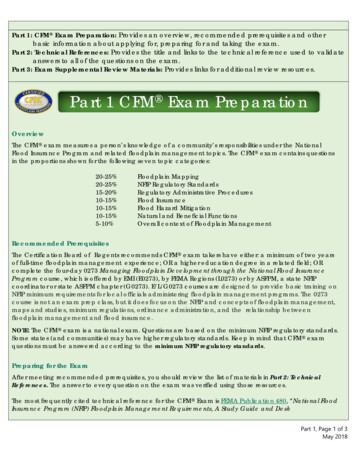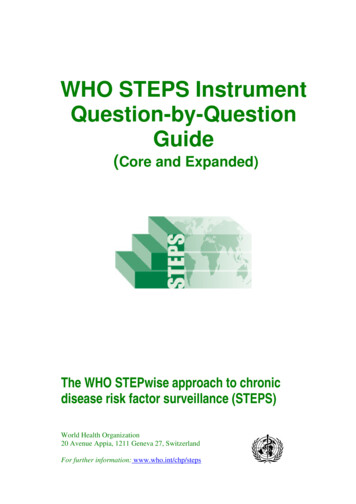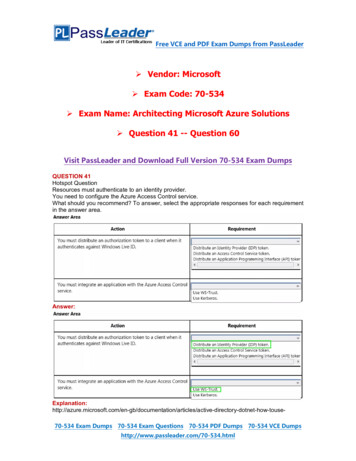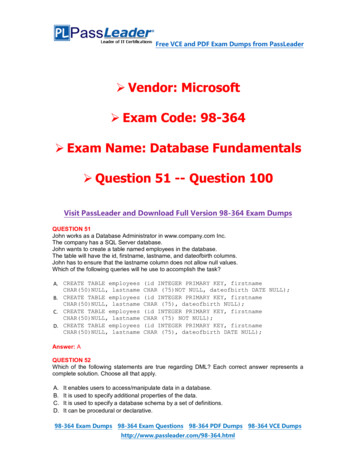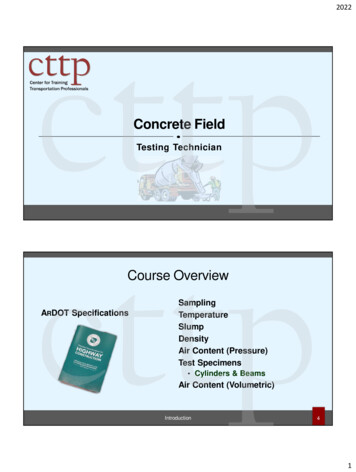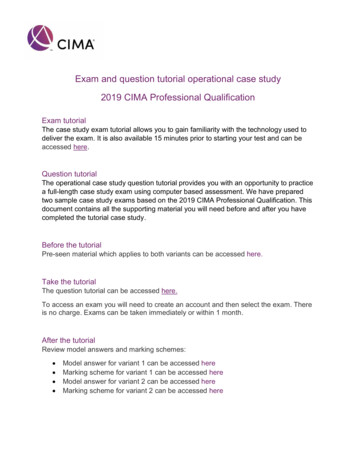
Transcription
Exam and question tutorial operational case study2019 CIMA Professional QualificationExam tutorialThe case study exam tutorial allows you to gain familiarity with the technology used todeliver the exam. It is also available 15 minutes prior to starting your test and can beaccessed here.Question tutorialThe operational case study question tutorial provides you with an opportunity to practicea full-length case study exam using computer based assessment. We have preparedtwo sample case study exams based on the 2019 CIMA Professional Qualification. Thisdocument contains all the supporting material you will need before and after you havecompleted the tutorial case study.Before the tutorialPre-seen material which applies to both variants can be accessed here.Take the tutorialThe question tutorial can be accessed here.To access an exam you will need to create an account and then select the exam. Thereis no charge. Exams can be taken immediately or within 1 month.After the tutorialReview model answers and marking schemes: Model answer for variant 1 can be accessed hereMarking scheme for variant 1 can be accessed hereModel answer for variant 2 can be accessed hereMarking scheme for variant 2 can be accessed here
Operational case study exam – 2019 syllabus prototype – pre-seen materialsOperational Case Study Examination2019 syllabus prototype – pre-seen materialsContents:1. Extract from job descriptionPage22. Company Information3-113. Industry Analysis12-134. Financial statements14-165. Management accounting information17-196. Tax regime in Celtland20News article – data analytics21News article – tackling inactivity221 CIMA 2019. No reproduction without prior consent
Operational case study exam – 2019 syllabus prototype – pre-seen materials1. Extract from job descriptionYou are a Finance Officer for GymFit. Your main role is to support Steven Potter, the FinanceManager. Your tasks include the production of the annual budget, producing the monthlymanagement accounts and providing information to management as required. You also assistwith the preparation of the financial statements and deal with any queries regarding financialreporting.2 CIMA 2019. No reproduction without prior consent
Operational case study exam – 2019 syllabus prototype – pre-seen materials2. Company InformationGymFit, is a fast growing, leading provider of low-cost gyms and one of the pioneers of thelow-cost gym model, which is based on relatively low gym membership fees and a ‘no-frills’service concept. It now has 102 gyms with 486,000 members based in major towns and citiesthroughout Celtland, Europe. The company was founded in 2005 using finance from venturecapitalist, Land Ventures. It is currently listed in the Celtland stock exchange and uses the C as its home currency.Revenue 2013 - 2018 in 142015201620172018The company has grown rapidly from sales revenue of C 17.8 million in 2013 to C 73.1 millionin 2018. The number of gyms it operates has also increased during the same period from 26gyms to 102. The rapid increase in the number of gyms has been through a mixture of organicgrowth and acquisition of existing gym groups. The company is now the 2nd largest operatorof low-cost gyms in Celtland.GymFit’s business model offers 24/7 gym operating hours and a no-contract membership i.e.there is no fixed membership period. The high specification gym equipment used is ecofriendly. In order to offer low membership fees, their model is based on a no-frills concept,meaning that facilities are restricted to the gym equipment, there are no wet facilities e.g.saunas or pools, and no café or bars that you would expect to find in a traditional health club.The low-cost model used by GymFit is dependent on advanced technology. ProspectiveGymFit members can join using a simple online process that can be completed in minutes.Members can also manage their accounts, view class timetables and book classes online.The use of technology results in an efficient staffing model with, for example, no need fordedicated in-gym sales and marketing teams.3 CIMA 2019. No reproduction without prior consent
Operational case study exam – 2019 syllabus prototype – pre-seen materialsMembershipGymFit membership is on a no-contract basis i.e. it does not involve a fixed membershipperiod and members are free to cancel their membership at any time without penalty. Thereare three types of membership: solo gym membership, where the member is able to accessonly one chosen gym; two gym membership, where the member can access two chosen gymsand bundle membership where the member can access gyms nationwide. These types ofmembership require payment of a monthly fee. In addition, it is possible to access gymfacilities on a daily basis by purchasing a day pass. Membership fees vary depending mainlyon the location of the gym. Occasional marketing campaigns are run offering discountedmembership to all new members. Student members also receive a discount.Each member is provided with a unique personal identification number (PIN) code which isused to provide electronic access to the gym and its facilities.Members have access to high quality fitness equipment, work-out areas and some free fitnessclasses. Other classes such as Pilates, yoga and dance fit are available on payment of anadditional fee. All new members are offered a free induction session and these are providedby the fitness instructors. The member can also, on payment of an additional fee, arrange forindividual coaching from a fitness instructor. These additional fees are paid directly to theinstructors and are a private arrangement between the gym member and the instructor. Otherfacilities offered include showers, changing areas, lockers and vending machines.4 CIMA 2019. No reproduction without prior consent
Operational case study exam – 2019 syllabus prototype – pre-seen materialsThe PeopleStaffThe average number of employees, during 2018, was 254. A typical gym has two employees,a manager and an assistant manager, who manage the running of the gym. The remainingstaff are employed at head office in various functions including IT, HR, Finance and Marketing.These employees are complemented by a number of freelance fitness instructors who arehired on a zero-hours contract where the instructors are not guaranteed to be offered work inany one week. The fitness instructors are paid a relatively low hourly rate but are able tosupplement their income with fees from individual coaching sessions.All fitness instructors are trained fitness experts. Their main role is to assist members withusing the equipment, run induction sessions for new members, lead some group classes, andprovide general exercise and fitness advice. They are also expected to carry out simplepreventative maintenance and testing the equipment. They can generally resolve most of thesimple problems arising with the equipment, anything they cannot deal with is referred to thecontracted maintenance company. In addition to this, they also refill vending and watermachines and, where possible, attend additional training sessions related to equipment use,fitness or health and safety.Gym managers are empowered to independently run their own sites, including the setting ofmembership fees, with bonus targets linked to gym performance. Other employees are givencompetitive remuneration including a defined contribution pension scheme and the opportunityto share in the company’s success through share incentive plans.The need for reception staff is eliminated due to the use of the electronic entry system and theonline membership and class booking system, other staffing needs such as cleaning, securityand non-routine machine maintenance are outsourced which means that gym staff (managersand fitness instructors) are free to concentrate on the core activities of the gym.5 CIMA 2019. No reproduction without prior consent
Operational case study exam – 2019 syllabus prototype – pre-seen materialsThe Senior Management TeamThe company’s senior management team bring to the company a wide range of previousexperience mainly in the leisure and retail industries. The team is relatively young, highlyenthusiastic and engenders a ‘can do’ culture throughout the organisation.The details of the company’s executive directors are given below:Bertram Durand (42) Chief Executive Officer (CEO)Bertram was appointed as CEO in 2014 and brings to thecompany extensive experience in the leisure and fitnessindustry.Nicola Collette (45) Chief Financial Officer (CFO)Nicola was appointed as Chief Financial Officer in 2015.She is a professionally qualified accountant. She has beenwith the company since it started operations in 2005 andwas responsible for the company's flotation on the Celtlandstock exchange.Jessica Treewood (38) Marketing DirectorJessica has been with the company since 2014. She holdsa BA in Marketing from Celtland University. She previouslyworked as Marketing Director for a competitor company inthe fitness club sector.Ethan Henson (38) Operations DirectorEthan was appointed Operations Director in 2016. He hasresponsibility for the running of the gyms and the HRfunction. He was previously a fitness trainer and hasworked his way up through the ranks of the company tobecome Operations Director.Gerard Fischer (46) Property DirectorGerard joined the company in 2011 as Property Director.He is responsible for the company's portfolio of properties.He is a qualified civil engineer and has vast experience inproperty management mainly gained in the hotel industry.Gemma Schneider (36) IT DirectorGemma joined the company in 2010 as an IT technicianand was appointed IT Director in 2017. She holds a MSc inInformation Technology. She is keen to further developGymFit's IT systems with the assistance of her team ofinnovative and highly qualified staff.6 CIMA 2019. No reproduction without prior consent
Operational case study exam – 2019 syllabus prototype – pre-seen materialsORGANISATION CHARTSExecutive and non-executive directorsBertram DurandChief Executive ica Karl Mann GemmaTreewoodNonSchneiderMarketing executive IT DirectorDirectorDirectorFinance DepartmentNicola ColletteChief Financial JeremyPascaleFinanceOfficerJoan JacobsFinanceOfficer7 CIMA 2019. No reproduction without prior consentNicolaColletteChiefFinancialOfficer
Operational case study exam – 2019 syllabus prototype – pre-seen materialsCompany OperationsThe GymsEach gym has more than 150 items of highspecification equipment and free weights formembers to use. The fitness equipment iseco-friendly with around 70% of themachines using no electricity and arepowered by the user instead. Each gymoffers a range of cardio machines includingrunning, cycling and step machines andweight machines of various types to helpflex every muscle in the body.The low-impact workout areas givemembers an opportunity to warm-up orstretch out. Equipment available includes exercise balls and yoga mats.Each gym contains studios for use by the fitness instructors when leading fitness classesincluding yoga, Pilates and Dancefit. There are also showers and changing facilities availableand vending machines selling bottled drinks and other fitness related items such as sweatbands, protein powder and health bars.Information Technology (IT)The IT department runs and manages the company’s website and is responsible for websitedevelopment. The company’s operations are driven by technology and the IT department isconstantly looking for new ways to utilise IT to improve the member proposition and to achievecost efficiencies.GymFit offers a simple online joining process that requires a valid email address and otherpersonal data. Membership and class fees can be paid by credit card, debit card and directdebit and members can manage their accounts, view class timetables and book classes usingcomputer, tablet or mobile. GymFit maintains a customer database which can be used tocommunicate with members.Gyms are open 24/7 but only staffed for around 16 hours of the day. The gyms have automatedaccess control and CCTV which is monitored on a 24-hour basis and is enhanced by the useof ‘panic buttons’ throughout the gym. It is the use of this technology which enables 24/7operation of the gyms whilst keeping costs low.The use of technology also results in an efficient staffing model, with no need for dedicatedin-gym sales and marketing teams. The staffing model means managers are freed from manytraditional health club tasks and can focus on running successful gyms and serving the needsof members.The extensive use of information technology brings other considerations in terms of systemfailure, data security and privacy. GymFit’s membership system, data processing, accountpayments, gym access, customer safety and customer marketing, are all dependent on the ITsystems. The systems hold a significant amount of confidential customer data including email8 CIMA 2019. No reproduction without prior consent
Operational case study exam – 2019 syllabus prototype – pre-seen materialsaddress, home address and bank details. A breach of data security would constitute asignificant risk to the company’s reputation and brand.MarketingThe marketing team’s main activities are market research; the promotion and advertising ofnew and existing gyms; raising brand awareness and advising on pricing strategies. TheMarketing team works closely with the IT and Properties department. Marketing efforts aredirected at both existing members, to try to ensure member retention, and the recruitment ofnew members.The marketing team uses the website to provide members with details of classes beingoperated each week and any other news or member offers. The customer database is alsoused to communicate electronically with members using email and SMS.Regular marketing campaigns ensure that the awareness of the brand is high. A recentcampaign featuring a leading Olympic athlete, Johnny Wren, resulted in a 2% increase inmember numbers.FinanceThe financial information system produces monthly management accounts and both halfyearly and annual statutory accounts. It also generates daily and weekly sales revenue andmembership number information for management to monitor actual results against budgets.The Finance team also carries out ad-hoc projects including investment appraisal andinvestigations, along with ongoing decision support. Some areas, including all internal auditwork, are delivered by external experts.Budgets are produced annually using incremental budgeting for sales and cost items. Allbudgets are broken down into monthly periods, with the exception of the sales budget whichis broken down into weekly periods.9 CIMA 2019. No reproduction without prior consent
Operational case study exam – 2019 syllabus prototype – pre-seen materialsPropertiesThe company has significant experience of developing and managing properties and has beenable to use that expertise and its close relationships with suppliers to reduce its fit-out andproperty management costs.Growth of the company is dependent on being able to find suitable properties for the newgyms. The company has plans to develop between 15 and 20 properties per year. The majorityof properties are leased, for periods of up to 15 years, whilst a small number are owned bythe company.Properties need to be large enough to accommodate the fitness equipment and offer studiospace for exercise classes. The ideal property is between 1,000 and 2,000 square metres,over a maximum of two floors. Properties need to be either located within a dense populationcatchment area to ensure sufficient potential local members or in highly visible locations witheasy car parking facilities or access to major transport hubs.10 CIMA 2019. No reproduction without prior consent
Operational case study exam – 2019 syllabus prototype – pre-seen materialsCompany StrategyThe company’s long-term objective is to deliver long-term profitable growth throughimprovements in operating efficiency, offering a strong member proposition and by focusingon its people.It plans to achieve growth through the selective acquisition of existing gym groups, and thelease and fit-out of new properties. The company has a rigorous approach to site selection,with flexible fit-out arrangements allowing the use of a wide variety of building types. It aimsto reduce gym fit-out costs through the use of a competitive tender process, negotiatingimproved terms with suppliers and value engineering the fit-out specification to avoidunnecessary cost.It plans to achieve improvement to operating efficiency through economies of scale, use ofdata and technology and also by managing its cost base. The outsourcing of support functionswill also enable cost reduction and allow the company to focus on core operations.In order to continually improve the member proposition, the company will pursue innovativelow cost ways to differentiate itself from its competitors. Improvement of member satisfaction,reflected in strong member satisfaction ratings, is a key aim which is dependent on havingknowledgeable, well-trained staff. The company strongly believes that attracting, motivatingand training people of the highest calibre is key to the company’s continued success.11 CIMA 2019. No reproduction without prior consent
Operational case study exam – 2019 syllabus prototype – pre-seen materials3. The Health and Fitness Industry in CeltlandCeltland health and fitness gym sector is a rapidly growing sector of the health and fitnessindustry. It has estimated sales revenue of C 7 billion in 2018, an increase of 6.3% on 2017.There are now over 9.7 million people in Celtland who are members of a gym.This sector experienced modest growth until 2011 thereafter the growth in the marketaccelerated rapidly, mainly driven by the low-cost segment. Prior to 2011 the marketcomprised of two main segments: public gyms funded by local government and private gymsfunded and operated by commercial enterprises. The rapid increase in low-cost gyms since2011 has fragmented the market by creating a third segment, low-cost (or budget) gyms,representing 12% of total private gym numbers in 2018.Gyms are differentiated by a number of factors, including price and contract terms, quality,scope of services and facilities, as well as whether they are part of a larger network.These can be broadly grouped into: Low-cost (or budget) gyms: these are private gyms and differentiate themselves by offeringaccess to gym facilities for a lower price, normally below (depending on the locationsometimes well below) C 20 per month. To contain costs, these gyms generally do notoffer access to ‘wet facilities’ (e.g., saunas, steam room, pools), operate large venues(above 1,000 square metres) and can generally be joined online. Also, they will normallytransparently advertise their prices online and offer monthly rolling contracts as an option.Mid-range and premium gyms: these are also private gyms but are more (or much more)expensive than low-cost gyms. They may, however, offer access to better facilities (e.g.wet facilities or a higher quality environment). These gyms can vary considerably in size,from very small facilities to very large ones. Some gyms will offer monthly rolling contractsand advertise their prices transparently online, others only offer longer-term contracts (e.g.minimum six months or one year) and sometimes require customers to contact the gym toobtain a quote.Public gyms: are owned and/or operated by, or on behalf of, local government. The qualityof the facilities offered by public gyms can vary considerably. In many instances, publicgyms also offer access to wet facilities, including a pool. Their pricing policy also variesconsiderably. Some business models in the operation of public gyms are similar to thosein the categories above.Recent government initiatives in Celtland, such as the ‘GetupGo’ campaign, have increasedconsumers awareness of the negative impact of an inactive lifestyle. The Society of MedicalPractitioners have made physical activity one of its top priorities hailing physical activity as thebest cure for lifestyle related diseases.Societal trends have also brought active lifestyles more prominence through the use ofFacebook, Instagram and Twitter. These trends have mainly influenced the youngergenerations who are consequently more health conscious than their predecessors.12 CIMA 2019. No reproduction without prior consent
Operational case study exam – 2019 syllabus prototype – pre-seen materialsMembership profile and customer demandThere are a number of determinants of gym membership with the most important being age;income and educational level.Previous research studies have shown that the highest percentage of gym members are inthe 18-35 age group however the fastest growing sector is the 36-55 age group. Income is amajor determinant with households earning 75,000 or more per annum being more likely tohave gym membership. However, within the high earners segment ( 75,000 and above)educational level was a significant factor with around 25% of those with degree level educationhaving gym membership compared to less that 12% of those who did not go to University orCollege.The overall penetration rate in Celtland is 14.3% but demand will be influenced by themembers’ proximity to the gym with most gym members being within 12 minutes driving timeof the gym. Proximity to good road or rail network will be a contributing factor. The extent ofcompetition in the specific areas will also be an important factor in estimating potentialdemand.Competitive SituationWithin the low-cost gym sector in Celtland there are four major players including GymFit.GymFit is the second largest operator in the sector in terms of number of gyms. The largestoperator Gym4All has grown mainly through the acquisition of other smaller gym groups. Anumber of smaller gym groups, typically operating between ten and thirty gyms, still remain.The rising star in the Celtland market is Fit4Life which has ruthlessly marketed itself as alifelong alternative to the other low-cost gyms. Fit4Life offers members a lifelong membershipfee which will not increase provided the customer remains a member. Its rapid growth hasalso been driven by its use of specialised fitness apps which have been developed using dataanalytics. These apps provide members with tailored personal training advice andprogrammes which they can access at home.Future OutlookGrowth in the Celtland health and fitness gym market is strong and steady and is expected tocontinue for the next few years driven by technology changes and government initiatives toimprove health and fitness.The Celtland health and fitness gym market is relatively immature compared to similar marketsin Europe. Norway, Sweden and the Netherlands all have mature markets with penetrationrates of 19.4%, 16.7% and 16.4% respectively. These penetration rates indicate that there ispotential for a strong increase in overall member numbers compared to Celtland’s currentpenetration rate of 14.3%.Whilst membership numbers are growing, operators still face the challenge of memberretention. Technology can minimise cancellations by making the gym experience moreenjoyable and rewarding, but operators must work to provide a service that members can’t getfrom exercising alone or by going elsewhere.The increasing presence of virtual reality (VR), immersive experiences and video-on-demand(VOD) is one way health and fitness clubs can achieve member retention. These technologiesallow gym operators to provide content in multiple locations at once, while freeing upinstructors. From a member perspective, VOD fitness can be accessed anywhere and at any13 CIMA 2019. No reproduction without prior consent
Operational case study exam – 2019 syllabus prototype – pre-seen materialstime thus eliminating the need to be at a gym at a certain time, or at all. Apps and onlinechannels also offer operators a way to help member’s access VOD fitness classes at home oraway.14 CIMA 2019. No reproduction without prior consent
Operational case study exam – 2019 syllabus prototype – pre-seen materials4. Extract from GymFit’s 2018 Consolidated FinancialStatementsStatement of Profit or Lossfor the year ended 31 December2018C 0002017C 000Revenue73,10258,831Gym operating costs(20,389)(16,384)Lease costs(13,840)(10,800)Staff 7)8,5696,5441212Finance costs(612)(633)Profit before tax7,9695,923(1,616)(990)6,3534,933Operating expensesHead office costsTotal operating expensesOperating profitFinance IncomeTaxationProfit / (loss) for the year15 CIMA 2019. No reproduction without prior consent
Operational case study exam – 2019 syllabus prototype – pre-seen materialsStatement of Financial Positionas at 31 December2018C 0002017C 000Intangible assets49,65348,974Tangible 4,6513663,8587,7538,636164,756127,1624848Share premium79,02779,027Retained earnings17,63212,357Total equity96,70791,432Non-current 7,2980065810735,97827,405164,756127,162Non-current assetsInvestmentCurrent assetsInventoriesTrade receivablesCash and cash equivalentsTotal AssetsEquity and LiabilitiesShare capitalCurrent liabilitiesTrade payablesBank loans and overdraftCurrent tax liabilitiesTotal Equity and Liabilities16 CIMA 2019. No reproduction without prior consent
Operational case study exam – 2019 syllabus prototype – pre-seen materialsStatement of Cash Flowsfor the year ended 31 December2018C 0002017C 401,154Net finance costs600621(Increase) / decrease in 6(612)(633)Tax paid(1,065)(882)Net cash generated from operating 1212(50,928)(22,180)Increase / (repayment) of long-term borrowings23,746966Dividend paid(1,078)(257)Net cash from/ (used in) financing activities22,668709Net increase / (decrease) in cash and cash equivalents(3,492)1,5703,8582,2883663,858Cash flows from operating activitiesProfit / (loss) before tax(Increase) / decrease in trade and other receivablesIncrease / (decrease) in trade and other payablesCash generated from operationsInterest paidCash flows from investing activitiesPurchase of tangible assetsPurchase of intangiblesInterest receivedNet cash used in investing activitiesCash flows from financing activitiesCash and cash equivalents at beginning of the yearCash and cash equivalents at the end of the year17 CIMA 2019. No reproduction without prior consent
Operational case study exam – 2019 syllabus prototype – pre-seen materials5. Budget information 2019Membership Fee Budget 2019CityNumber of gymsAverage number of members per gymAverage membership fee per month(C )Total membership fees per year(C alSales Budget 2019Number of gyms116Average number of membersper gym4,500Total sales revenue (C 000)92,394PermemberC Average membership fees170.00Classes5.28Vending machine income1.45Day passesTotal sales revenue18 CIMA 2019. No reproduction without prior consentNumber ofmembers per gym4,5004,5004,500TotalC 00088,7402,75675714192,394
Operational case study exam – 2019 syllabus prototype – pre-seen materialsOperating Profit Budget 2019Total 000Sales revenuePer gym 000 00092,394 000796Operating expensesGym operating costs(23,920)(206)Lease costs(16,991)(146)Staff 126)Amortisation(1,040)(9)Head office costsOperating profit19 CIMA 2019. No reproduction without prior consent(76,610)(660)15,784136
Operational case study exam – 2019 syllabus prototype – pre-seen materialsGymFit Key Total number of gyms1161027159New gym openings14311215*Number of mature gyms71594432Total number of members548,100485,600358,400300,800Average number of members522,000422,586344,066283,908Average number of membersper gym4,5004,1434,8464,812Total sales revenue (C 000)92,39473,10158,83147,983Sales revenue per memberper year 177 173 171 169Total number of operationalemployees225198138114*Mature gyms are those gyms which have been operating for more than 2 years.20 CIMA 2019. No reproduction without prior consent
Operational case study exam – 2019 syllabus prototype – pre-seen materials6. The Tax Regime in CeltlandCorporate Profits: The corporate tax rate applicable to taxable profits is 20%.The sales tax rate is 20%.Unless otherwise stated below, accounting rules on recognition and measurement arefollowed for tax purposes.The following expenses are not allowable for tax purposes:o accounting depreciation;o amortisation;o entertaining expenditure;o donations to political parties; ando Taxes paid to other public bodies.Tax depreciation allowances are available on items of plant and machinery (includingvehicles used for business purposes) at a rate of 25% per year on a reducing balancebasis.Tax losses can be carried forward to offset against future taxable profits from the samebusiness.21 CIMA 2019. No reproduction without prior consent
Operational case study exam – 2019 syllabus prototype – pre-seen materialsFitness Monthly16 January 2019No. 78C 4.70Is data analytics thefuture for the fitnessindustry?Georgio Duccatti - Business CorrespondentWe live in a world driven bytechnology. The fitness industry is noexception, as the opportunity to usetechnology and data promises a stepchange in th
Operational case study exam - 2019 syllabus prototype - pre-seen materials . 6 CIMA 2019. No reproduction without prior consent . The Senior Management Team . The company's senior management team bring to the company a wide range of previous experience mainly in the leisure and retail industries. The team is relatively young, highly
